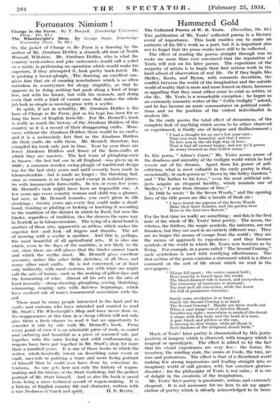Fortunatos - - Minium Change in the Farm. By T. Hannan. (Cambridge
University University Press. 75. 04.) -- • - - - ON the jacket of Change in .theFarm is a drawing by the author of Mr. Abraham Holder, a staunch old man of North Wraxall, Wiltshire. Mr. Abraham Holder, who is what the country week-enders and joke cartoonists would call a yokel or a rustic, is performing an operation which would make his superiors, if they attempted it, look pretty buck-fisted. He is pushing a breast-plough.,,;The drawing, an excellent one, gives him that air of cunning nonchalinCe which is so often mistaken in countrymen- for sleepy stupidity, so that he appears to be doing nothing but push along a kind of large hoe, not with his breast, but with his stomach, and doing even that with a kind of vacant ease that makes the whole job look as simple as mowing grass with a scythe.
In spirit, if not in actuality, Mr. Abraham Holder is the hero of Change in the Farm, just as his type has been for so
long the hero of English farm-life. For Mr. Hennell's book is really as much the history of the Abraham Holders of this country as it is a record of their disappearing crafts. More- over, without the Abraham. Holders there would be no crafts, and it is a melancholy fact that as the Abraham Holders die their crafts die with them. Mr. Hennell, therefore, has compiled his book only just in time. Year by year there arc fewer Abraham Holders and fewer of the farm-crafts at which they are masters. The last team of ploughing-oxen in Sussex—the last but one in all-England—was given up in 1929 ; a common wooden swing-plough of traditional design has for the last sixty years and until recently been made in Gloucestershire—but is made no longer ; the threshing flail, once so common, is no longer used except in isolated places.
So with innumerable farm-crafts. In ten or even five years Mr. Hennell's task might have been an impossible one. A few years ago every country woman and child was a gleaner, but now, as Mr. Hennell remarks, you can't glean in silk stockings ; twenty years ago every boy could make a sheaf- bond, twisting or plaiting or locking or knotting it according to the tradition of the district •in which he lived, but now the binder, regardless of tradition, ties the sheaves the same way in Norfolk as in Gloucestershire. The tying of a sheaf-bond is another of those arts, apparently so artless, which makes the
superior feel—and look fingers and thumbs. The art of mowing with a scythe is another. And this is, perhaps, the most beautiful of all agricultural arts. It is also one which, even in the days of the machine, is not likely to die out, since there are still places that the binder cannot touch and which the scythe must. Mr. Hennell gives excellent accounts, rather like sober little sketches, of all these and many other rural crafts. He is not concerned, or at least only indirectly, with rural customs, nor with what one might call the arts of luxury, such as the making of pillow-lace and the fermenting of wine. Almost all his arts are the arts of hard necessity—sheep-shearing, ploughing, sowing, thatching, winnowing, reapingarts . with -dateless beginnings, which have evolved out of man's immemorial association with the
soil.
There must be many people interested in the land and its
crafts and customs who have intended and wanted to read Mr. Sturt's The Wheeheright's Shop and have never done so. Its reappearance at this time in a cheap edition will not only give them a fresh chance to read it but an opportunity to consider it -side by side with - Mr. • Hennell's book. , From
every point of view it is an admirable piece of work, as sound and enduring and beautiful as a piece of seasoned oak, put together with the same loving and solid craftsmanship as
wagons have been put together in -Mr.' Sturt's shop for more
than a hundred years. It is one of those books in which the writer, whole-heartedly intent on describing some event or craft, sucezed.s in painting a truer and more living .portrait of himself than he could ever have -done by conscious in- tentions. So one gets her ,not only the history of wagon- making and the history of the Sturt workshop, but the perfect portrait of Mr. Stud himself. And so also the bobk is saved from being a mere technical record of wagon-making. It is a history of English country life -and character, written with
a rare freshness OF touch and spirit;- U. E.
















































 Previous page
Previous page